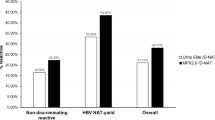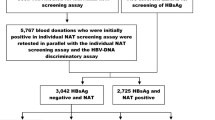Abstract
Genome amplification technologies (GAT) provide a new approach for testing blood donations for viruses. After extraction of nucleic acids, the target sequence is hybridised by virus specific probes. Various amplification processes of the target (PCR, NASBA, TMA, SDA) or of the probe signal (bDNA, LCR), as well as several detection methods allow for a very high sensitivity. The more general term “nucleic acid amplification testing” (NAT) tends to be preferred to GAT considering the array of technical approaches. In the last 5 years, advances in extraction, amplification and detection steps led to better mastered techniques and commercially available tests kits. Thus, from the technical standpoint, viral genomic screening (VGS), appears to be a realistic potential addition to the present tests carried out on blood donations. As it is targeted at the essence of viruses, nucleic acids, VGS is a direct test in contrast with antibody screening presently used for HCV or HIV. In the latter case, VGS is expected to better reduce the window period than HIV p24 antigen screening. Therefore VGS appears to be the direction of improvement in the detection of window period donations.
Access this chapter
Tax calculation will be finalised at checkout
Purchases are for personal use only
Preview
Unable to display preview. Download preview PDF.
Similar content being viewed by others
References
Hewlett DC, Epstein JS. Food and Drug Administration conference on the feasibility of genetic technology to close the HIV window in donor screening. Transfusion 1997;37:346–51.
Nubling CM, Wilkommen H, Lower J. Hepatitis C transmission associated with intravenous globulins. Lancet 1995;345:1174
CPMP Intramuscular immunglobulins: nucleic acid amplification tests for HCV RNA detection. CPMP/117/95
CPMP. The introduction of genomic amplification technology (GAT) for the detection of hepatitis C virus RNA in plasma pools. CPMP/BMP/390/97
CPMP Note for guidance on plasma derived medicinal products. CPMP/BWP/269/ 95, rev.2
Diekamp U, Kamutzky K, Windel CD. Anti-HCV-Pravalenz und -Inzidenz bei 2,8 Millionen niedersachsischen Blutspenden—transfusionsassoziiertes HCV-Restrisiko.: Beitr Infusionsther Transfusionsmed 1997; 34:5–10
Paul-Erlich-Institut Bundesinstitut fur Sera und Impfstoffe: Bekannmachung uber die Ergebnisse des Stufenplanverfahrens zur Verminderung des Risikos von Hepatitis B-, Hepatitis C- und HIV-Infektionen bei Emmpfangern von Erythrozyten Konzentraten. Bundesanzeiger, 18 Marz 1998;53:3835–36.
Courouce AM, Pillonel J et les groupes de travail Retrovirus et Hepatites Virales de la Societe Francaise de Transfusion Sanguine. Risque de transmission d’infections virales par transfusion de derives sanguins labiles. Medecine therapeutique 1997,3: 858–62
Busch MP, Stramer SL, Kleinman SH. Evolving applications of nucleic acid amplification assays for prevention of virus transmission by blood compnents and derivatives. In: Garatty G ed. Applications of molecular biology to blood transfusion medicine. Bethesda, MD : American Association of Blood Banks 1997:123–77
Kleinman SH, Busch MP, Korelitz JJ, Schreiber GB.The incidence/window period model and its use to assess the risk of transfusion transmitted HIV and HCV infections. Transfus Med Rev 1997; 11:155–72
Font TS, Di Bisceglie AM, Biswas R, Waggoner JG, Wilson L, Clagett J, Hoofnagle JH. High levels of viral replication during acute hepatitis B infection predict progression to chronicity. J Med Virol 1994;43:155–58
Jagodzinski L, Kraus F, Garrett P, Schumacher R, Manak M. Detection of hepatitis B viral sequences in early HBV infection. Transfusion 1994;34(suppl):S148 (abstract).
Nubling CM, Seitz R, Lower J. Applications of nucleic acid amplification techniques for blood donation screening. Infusionsther Transfusionmed 1998;25:86–90
Quint WGV, De Bruijn I, Kruining H, Heijtink RA. HBV-DNA detection by gene amplification in acute hepatitis B. Hepatology 1990;12:653–56
Flanagan P; Snape T Nucleic acid technology (NAT) testing and the transfusion service: a rationale for the implementation of minipool testing [editorial]. Transfus Med 1998;8:9–13
AuBuchon JP; Birkmeyer JD; Busch MP Cost-effectiveness of expanded human immunodeficiency virus-testing protocols for donated blood. Transfusion 1997;37: 45–51
Author information
Authors and Affiliations
Editor information
Editors and Affiliations
Rights and permissions
Copyright information
© 1999 Springer Science+Business Media Dordrecht
About this chapter
Cite this chapter
Noël, L. (1999). GAT Testing: Added Value?. In: Sibinga, C.T.S., Alter, H.J. (eds) Risk Management in Blood Transfusion: The Virtue of Reality. Developments in Hematology and Immunology, vol 34. Springer, Boston, MA. https://doi.org/10.1007/978-1-4757-3009-8_9
Download citation
DOI: https://doi.org/10.1007/978-1-4757-3009-8_9
Publisher Name: Springer, Boston, MA
Print ISBN: 978-1-4419-4822-9
Online ISBN: 978-1-4757-3009-8
eBook Packages: Springer Book Archive




